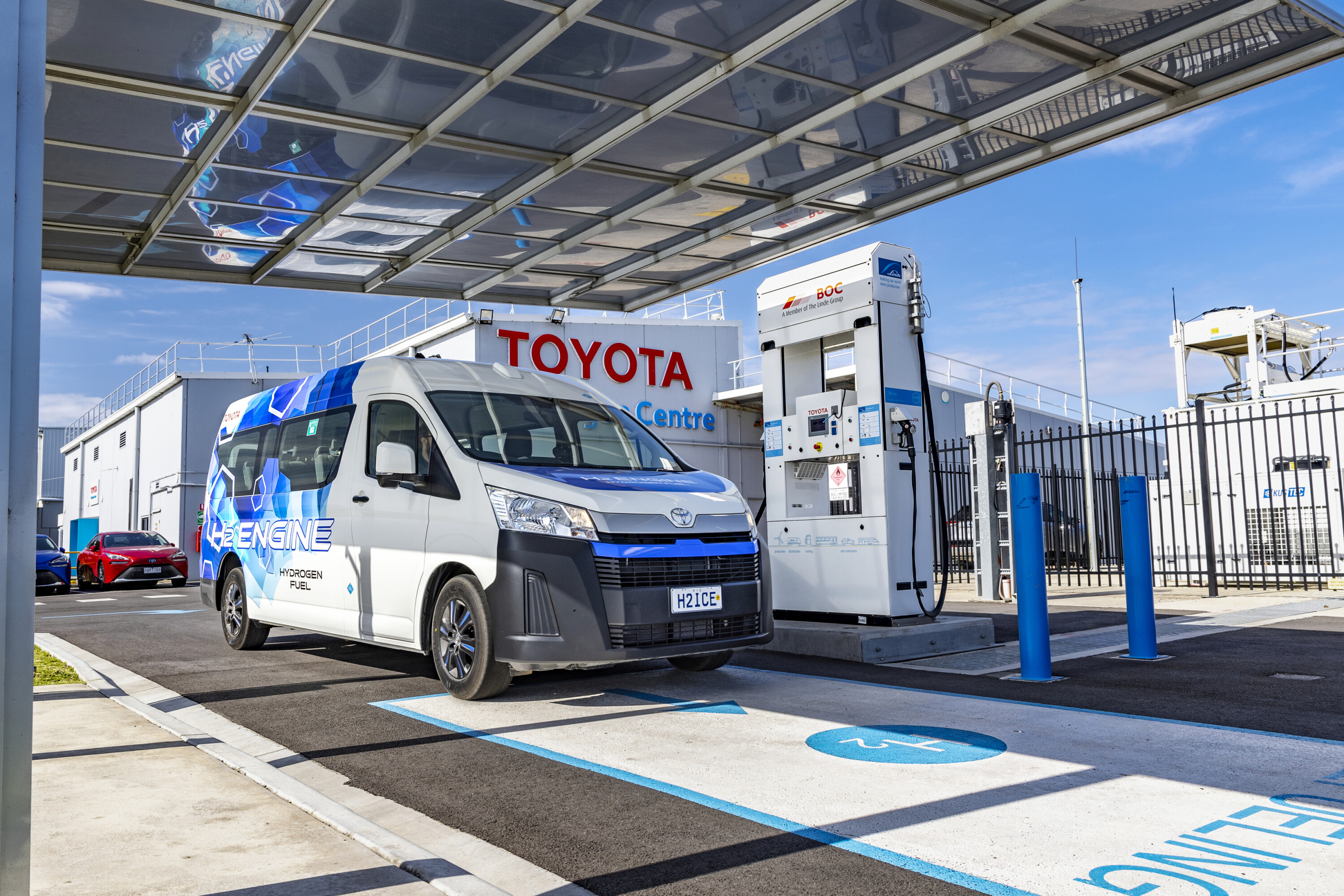
Snapshot
- Prototype HiAce uses u2018hydrogen-to-iceu2019 and is powered by a 3.5-litre twin-turbo V6
- The prototype will be evaluated by several Aussie companies in a world first u2018pilot programu2019
- u2018Hydrogen-to-iceu2019 is cheaper the fuel-cell EVs to produce and brings no comprises to towing or loading ability, says Toyota
- HiLux and LandCruiser could be candidates for the same hydrogen powertrain, says Toyota
Toyota has revealed a hydrogen-fuelled version of its HiAce van that’s pitched as a more cost-effective way to drive a low-emissions vehicle.
Revealed yesterday at Toyota’s hydrogen facility in Altona, the new prototype is powered by a 3.5-litre twin-turbo V6 that’s fuelled by hydrogen rather than petrol and doesn’t bring any compromises when it comes to towing or packaging.
Toyota also says its ‘hydrogen-to-ice’ tech is a cheaper alternative to existing fuel-cell EVs (FCEV) or battery electric vehicles (BEV) because most of the powertrain is based on existing hardware – the same V6 already powers the Lexus LX600.

“Importantly, we have used the proven petrol engine technologies which means we can keep the supply chain we have built up over many years,” said Mitsumasa Yamagata, the president of Toyota’s hydrogen factory.
“This reduces the amount we need to invest, which helps contain the overall development cost.”
The new model is yet to be confirmed for production but Toyota’s vice president of sales and marketing, Sean Hanley, said its price premium over a diesel HiAce van could be similar to Toyota’s current pricing for hybrid models.
“There will be some ‘up spec’ because there’s some development costs, but they’re nowhere near what it would be if you started from scratch to develop a whole fuel cell electric vehicle,” said Hanley. “So it’d be fairly close, you’re talking about 10 percent close. Maybe similar to hybrid right now.”

Toyota will use the hydrogen HiAce as part of a world-first ‘pilot program’ where it will be driven by several large Australian companies in order to evaluate the new powertrain tech for wider use in Toyota’s range.
The Toyota LandCruiser and HiLux are both possible candidates to receive the hydrogen-to-ice powertrain, with Toyota confirming it’s already exploring how to fit the LandCruiser with hydrogen power.
“Yes, there is the possibility to adapt into those large vehicles including LandCruiser,” said Mr Yamagata. “And again the advantage of this technology can be utilised in those vehicles including high towing and high loading.”

The prototype HiAce has a range of around 200km, although Toyota’s execs were quick to explain the production version would offer far more range.
“We are already working on much bigger hydrogen tanks and there’s also the possibility of adding our famous hybrid electric technology,” said Yamagata.
“What you see today is not the endgame, it’s the start” added Hanley. “So when you start to develop the technology and realise that you can put the bigger fuel tanks in it you’d be looking at a vehicle that could probably do 500, 600 or 700km on a tank with less than 10 minute refuelling.”
Performance is another potential area due for development. The prototype vehicle makes 120kW/354Nm, which is on par with a diesel HiAce, yet well down on the 305kW/650Nm that the same 3.5-litre twin-turbo V6 engine makes in the Lexus LX600.

The prototype HiAce uses three hydrogen tanks, similar in layout to the Toyota Mirai FCEV, and it retains the same amount of luggage space and passenger room as a diesel-powered HiAce.
Towing capacity is another advantage of hydrogen-fuelled vehicles, says Toyota, and the prototype has a braked towing capacity of 1500kg.
While the hydrogen prototype has virtually zero C02 tailpipe emissions, it does produce a small amount of nitrogen oxides (NOx) as it still burns oil and needs to ignite the fuel inside the combustion chamber.
The prototype HiAce is the latest step in Toyota’s bid to be a world leader in hydrogen-powered vehicles.

A small fleet of Mirai FCEV sedans are currently on long-term leases to several Australian companies and in 2021 Toyota commissioned Victoria’s first hydrogen production, storage and refuelling facility in Altona.
And last month, Toyota and Hyundai signed an agreement with Ampol and Pacific Energy to increase the number of hydrogen refuelling stations in Australia.
Toyota isn’t the first company to explore ‘hydrogen-to-ice’ vehicles. Mazda launched the RX-8 RE in 2004, while the BMW Hydrogen 7, which used a 6.0-litre V12, was built in limited numbers between 2005-2007.
Both brands have since abandoned the concept.
We recommend
-
 News
News2023 Toyota HiAce and Granvia pricing and features: HiAce gains barn door option
Toyota is offering its popular HiAce van with an ergonomic rear-loading option, while pricing has increased for the new model-year
-
 News
NewsToyota, Yamaha developing hydrogen-fuelled V8
Despite announcing a plethora of EVs for the future, Toyota isn't done with ICE development




